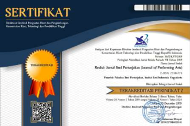"Grain Gamelan": Adaptation of One More Grain Band's Songs to Gamelan Pelog Slendro
Abstract
Keywords
Full Text:
PDFReferences
Anshel, M. H., & Marisi, D. Q. (1978). Effect of music and rhythm on physical performance. Research Quarterly of the American Alliance for Health, Physical Education and Recreation, 49(2), 109–113. https://doi.org/10.1080/10671315.1978.10615514
Borgdorff, H. (2016). The Conflict of the Faculties: Perspectives on Artistic Research and Academia (Vol. 15, Issue 2). Leiden University Press. https://library.oapen.org/handle/20.500.12657/32887
Gunawan, I., Milyartini, R., & Masunah, J. (2022). The Use of Laras in Contemporary Gamelan Music. Harmonia: Journal of Arts Research and Education, 22(1), 161–173. https://journal.unnes.ac.id/nju/index.php/harmonia/article/view/35483/13107
Gunawan, I., & Quinn, D. P. (2022). Grain Gamelan. Https://Onemoregrain.Bandcamp.Com/Album/Grain-Gamelan.
Hardjana, S. (2004). Musik Antara Kritik dan Apresiasi. PT Kompas Media Nusantara.
Hendriyana, H. (2021). Metodologi Penelitian Penciptaan Karya (P. Christian, Ed.; II). ANDI.
Le Conte, S., Vaiedelich, S., & Bruguiere, P. (2008). Acoustical measurement of Indian musical instruments (vina-s): Towards greater understanding for better conservation. Proceedings - European Conference on Noise Control, June, 3335–3339. https://doi.org/10.1121/1.2934019
Lovink, G. (2016). Dancing to the Loop: Repetition in Contemporary Music - An Interview with Tilman Baumgärtel. Dancecult, 8(1). https://doi.org/10.12801/1947-5403.2016.08.01.10
Mack, D. (1994). Ilmu Melodi. Pusat Musik Liturgi.
Mack, D. (2004). Sejarah Musik Jilid IV (4th ed.). Pusat Musik Liturgi.
Mulyati, S., & Suparli, L. (2021). Praktik Ritual Tari Tarawangsa Pada Sajian Bentuk Garap “Pohaci” (Tembang Tubuh Padi).
Pramudya, Y., Widayanti, L., & Melliagrina, F. (2018). Frequency Measurement of Bonang Barung and Peking in Javanese Gamelan using Audacity. Journal of Physics: Conference Series, 1075(1). https://doi.org/10.1088/1742-6596/1075/1/012047
Putu, N., Sintya, V., & Ardini, N. W. (2021). " Bali-Kang ": A Minimalist Music with Western , Balinese , and Chinese Elements. 4(1), 81–100.
Quinn, D. P. (n.d.). One More Grain. Retrieved October 9, 2023, from https://onemoregrain.bandcamp.com/
Roma, G., & Serra, X. (2015). Music performance by discovering community loops. 1st Web Audio Conference, i.
Russell, L. (2013). Music and Emotions: Research on The Theory of Musical Equilibration. 2(4), 4–6.
Shiokawa, H., Umeda, H., Minagawa, K., & Kartawan, I. M. (2016). Changes of Balinese Gamelan in Indonesia -Pitch of Gamelan Gong Kebyar Relating to Educational Institutions.
Sjukur, S. A. (2014). Sluman Slumun Slamet-Esai-esai Salmet Abdul Sjukur (1976-2013) (Erie Setiawan, Ed.; 1st ed.). Art Music Today.
Sumarsam. (1995). Gamelan: Cultural Interaction and Musical Developtment in Central Java. The University of Chicago Press.
Sunarto. (2018). Claude_Debussy_dan_Gamelan_Jawa. Pelataran Seni, 3(1), 1–14.
Supiarza, O. H. (2016). Minimax Sebagai Konsep Berkarya Slamet Abdul Sjukur Dalam Penciptaan Musik Kontemporer. In RITME Jurnal Seni dan Desain Serta Pembelajarannya (Vol. 2, Issue 2).
Supriatna, N. (2015). The Transformations of Tarawangsa Traditional Music in the Ritual Ceremony of Bubur Syura in Sukaluyu Village. TAWARIKH: International Journal for Historical Studies, 6(2), 189–196.
Torun, O. (2023). Musical Minimalism: Is It a Misnomer? Porte Akademik Müzik ve Dans Araştırmaları Dergisi, 24, 111–122. https://doi.org/10.59446/porteakademik.1292776
Wibisono, J. (2012). Gamelan in the Blood. CSEAS Newsletter, 1879–1882.
DOI: https://doi.org/10.24821/resital.v24i3.11172
Article Metrics
Abstract view : 0 timesPDF - 0 times
Refbacks
- There are currently no refbacks.
This work is licensed under a Creative Commons Attribution 4.0 International License.




